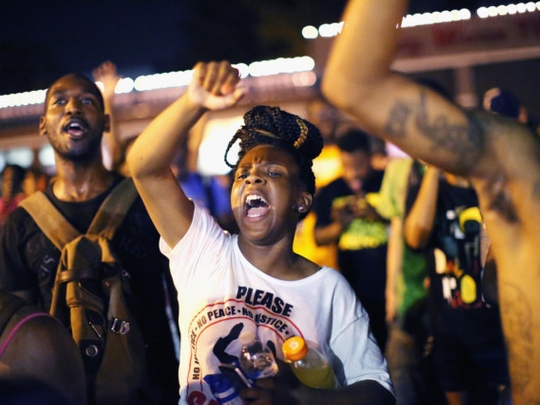
Just outside a mall in Ferguson, Missouri, shortly after 10 o’clock on Wednesday, a black man in his 30s was stopped and frisked by around eight white policemen. As he gingerly emptied his pockets, careful not to move too quickly, he yelled at them. It was a soliloquy of pure rage; a fluent, apparently unstoppable oration against not just the men who had apprehended him but the system they represented.
“Yes I’m angry,” he shouted. “Four hundred years we been here. We built this place for free and y’all still hate us.” A man filming the incident was told to move on but did not budge. When the police let the pedestrian go (whatever they were looking for he didn’t have), the man recording went too. “I’ve done my job,” he said.
“All books about all revolutions begin with a chapter that describes the decay of tottering authority or the misery and sufferings of people,” wrote Polish journalist Ryszard Kapuscinski in Shah of Shahs. “They should begin with a psychological chapter, one that shows how a harassed, terrified man breaks his terror and stops being afraid. This unusual process demands illuminating. Man gets rid of fear and feels free.”
For the past fortnight, the black population of this St Louis suburb has been shedding its fear. Since Michael Brown, an 18-year-old black man, was shot six times while raising his hands in a surrender position, they have asserted their humanity in ways big and small, beautiful and ugly. Every night they marched up the main drag in the black part of town, past militarised encampments of armed police, chanting: “Hey, hey, ho, ho, killer cops have got to go.” Every day around town impromptu gatherings of anything from four to a dozen people would spring up in the street, like mini town hall meetings, to debate the source of the problem both in Ferguson and the country at large. “Don’t shoot, I’m with a white guy,” one said as he walked towards some policemen with his friend.
Invisible poor
For anyone sceptical about what the past two weeks have achieved, it was this. When hundreds of black protesters faced off against lines of white police armed as though for military combat, they brought the inequalities and inequities in the town into sharp focus and gave themselves the courage to both challenge and expose them.
“That the poor are invisible is one of the most important things about them,” wrote Michael Harrington in his book, The Other America. “They are not simply neglected and forgotten as in the old rhetoric of reform; what is much worse, they are not seen.” Not only do black people in Ferguson now see themselves differently, the town’s white establishment is seeing them for the first time. While no one could reasonably claim black people here had previously been living in tyranny — they had the vote but precious few used it to shape local matters — they had clearly not been ruled by consent either. In this majority black town, they considered the overwhelmingly white police force hostile and the local government indifferent. With the world’s media present, one policeman from a nearby county pointed his semi-automatic gun at a protester and told him: “I will f***ing kill you.” When asked his name, he said, “Go f*** yourself”. Another struck an eight-year-old with a tear gas canister. It got so bad that the local police were replaced by the state highway patrol. If that’s how officers behave when they know they’re under scrutiny, imagine what they’re like when they think no one is watching.The most remarkable thing about Michael Brown is not that he was killed by the authorities in broad daylight. That, sadly, is not an unusual occurrence in America. Since his death, at least three black men have been killed by the police. The most recent case was less than 10 minutes away, in St Louis itself. Kajieme Powell, a mentally-ill man armed with a knife who was standing 20 feet away from police, was shot — a response that bore more resemblance to the work of a death squad than a police force.
No, what marks Brown out is that we are still calling his name; that beyond his immediate community there is interest in the circumstances of his death; that the federal government has intervened. Those in the media who slammed the occasionally violent protests must at least concede that, were it not for the disturbances, they would never have paid attention. Brown would be one more dead black kid and Darren Wilson, the policeman who shot him, would be back on the beat instead of on paid leave.
What the next chapter brings is not clear. The protests are winding down; the national guard is being withdrawn; the media are leaving. Only the courts can ascertain Wilson’s guilt or innocence. But the judicial system that let George Zimmerman, the killer of Trayvon Martin, walk free inspires little confidence in many. The black community in Ferguson may now be visible, but the justice it seeks may prove more elusive.
— Guardian News & Media Ltd












